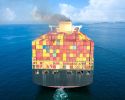Delivery at any price

In the US, Amazon's items have had an average price increase of 25 percent since January. The cause of this is believed to be increased transport costs and large investments to better control the complicated supply chain. IKEA, Walmart and Target have done the same. A new report points to strong ties between the retail giants and the world's 15 largest container companies.
At the end of November, freight analyst Steve Ferreira told CNBC that there were 79 ships outside Los Angeles waiting up to 45 days to com into the harbour. In the last days, he had also followed how Amazon's latest self-chartered ship entered the United States via a small port in the state of Washington.
“It waited to days in the harbour.”
The goods were then driven by truck to Los Angeles.
“So Amazon’s really taken advantage of some of the niche strategies I believe that the market needs to employ”, Ferreira stated.
Amazon now ships 72% of its goods itself. Despite this, Amazon has seen a 14% rise in out-of-stock items and an average price increase of 25% since January 2021, according to e-commerce management platform. It’s easy to understand. Last year Amazon spent $ 61 billion on shipping, which is comparable to $ 38 billion in 2019.
“Ultimately, when there’s an increase in the cost of transportation, it gets passed down to the consumer”, said Margaret Kidd, a logistics researcher at the University of Houston in the same feature.
Amazon is not alone in the retail trade in investing in its own shipping. An ever-increasing pressure on consumption, which became particularly evident during the pandemic year, has also led IKEA, Walmart and Target to do the same. According to the report Shady Routes, produced by the Stand.earth research group and the Pacific Environment, close cooperation between individual retail giants and various container companies has led to record breaking profits.
The companies are satisfied. It is also, one must assume, the customers who pay more for their stuff than they did just a few months ago. The big loser is the climate. If shipping were a country, it would be the world's sixth largest climate polluter, the researchers write in the report. The four companies surveyed (Walmart, Target, Amazon and
IKEA) imports of goods to the United States via shipping in 2018-2020 accounted for an estimated 20 million tonnes Carbon dioxide equivalents.
The shipments were made by a few of the world's largest container companies with which the retail giants have long had close collaborations. The French carrier CMA CGM, which handles most of Walmart's transports to the United States, is the worst polluter of alla carriers in the report. The company alone accounted for 35 percent of the four trading companies' greenhouse gas emissions, which is about as much as the four following carriers on the list emitted together. The second largest polluter, Maersk, accounted for 9 percent. CMA CGM made a profit of $ 31 billion by 2020.
Walmart is the largest importer, accounting for more than half of the four companies' climate emissions, followed by Target, which accounted for a third. Amazon and Ikea, which together accounted for only 13 percent of emissions, are highlighted in the report for their investments in green transport. Ikea, for example, transports its goods by rail from China to Europe before being shipped on to the USA via shipping.
-
 NextWave – en podd som ska locka unga
NextWave – en podd som ska locka unga -
 Ny studie: Eldrivna pendelbåtar kan effektivisera Stockholms kollektivtrafik
Ny studie: Eldrivna pendelbåtar kan effektivisera Stockholms kollektivtrafik -
 Sjöfartens utsläpp ökar
Sjöfartens utsläpp ökar -
 Sociala relationer påverkar val av bränsle
Sociala relationer påverkar val av bränsle -
 Sjöfartens omställning kräver ”mjukare” påtryckningar
Sjöfartens omställning kräver ”mjukare” påtryckningar -
 Hon hade avtalad tid med Kapten ynkrygg
Hon hade avtalad tid med Kapten ynkrygg -
 Lighthouse omvärldsanalys 2025 – osäkerhet och tullar präglar sjöfarten
Lighthouse omvärldsanalys 2025 – osäkerhet och tullar präglar sjöfarten -
 Se seminariet Shipping in the Marine Environment
Se seminariet Shipping in the Marine Environment -
 Vad betyder egentligen de 90 procenten?
Vad betyder egentligen de 90 procenten? -
 Hålla där...
Hålla där...

